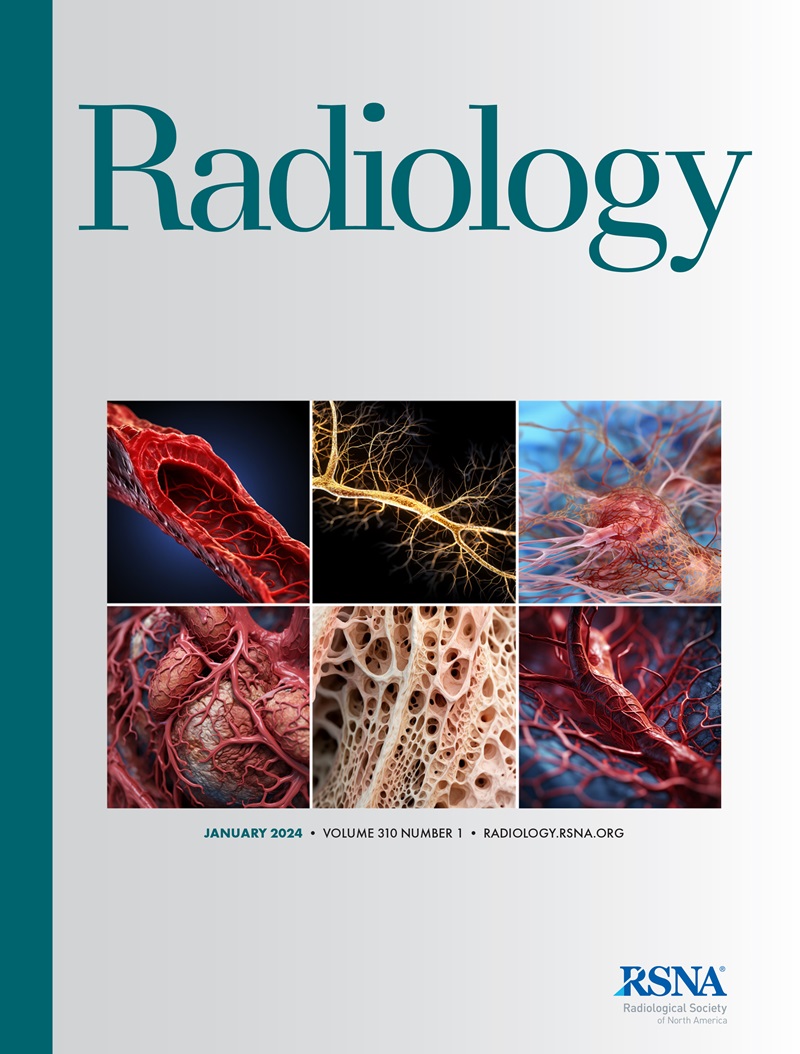Deuterium Metabolic Imaging of Alzheimer Disease at 3-T Magnetic Field Strength: A Pilot Case-Control Study.
Alixander S Khan, Katie A Peterson, Orsolya I Vittay, Mary A McLean, Joshua D Kaggie, John T O'Brien, James B Rowe, Ferdia A Gallagher, Tomasz Matys
下载PDF
{"title":"Deuterium Metabolic Imaging of Alzheimer Disease at 3-T Magnetic Field Strength: A Pilot Case-Control Study.","authors":"Alixander S Khan, Katie A Peterson, Orsolya I Vittay, Mary A McLean, Joshua D Kaggie, John T O'Brien, James B Rowe, Ferdia A Gallagher, Tomasz Matys","doi":"10.1148/radiol.232407","DOIUrl":null,"url":null,"abstract":"<p><p>Background Impaired glucose metabolism is characteristic of several types of dementia, preceding cognitive symptoms and structural brain changes. Reduced glucose uptake in specific brain regions, detected using fluorine 18 (<sup>18</sup>F) fluorodeoxyglucose (FDG) PET, is a valuable diagnostic marker in Alzheimer disease (AD). However, the use of <sup>18</sup>F-FDG PET in clinical practice may be limited by equipment availability and high cost. Purpose To test the feasibility of using MRI-based deuterium (<sup>2</sup>H) metabolic imaging (DMI) at a clinical magnetic field strength (3 T) to detect and localize changes in the concentration of glucose and its metabolites in the brains of patients with a clinical diagnosis of AD. Materials and Methods Participants were recruited for this prospective case-control pilot study between March 2021 and February 2023. DMI was performed at 3 T using a custom birdcage head coil following oral administration of deuterium-labeled glucose (0.75 g/kg). Unlocalized whole-brain MR spectroscopy (MRS) and three-dimensional MR spectroscopic imaging (MRSI) (voxel size, 3.2 cm cubic) were performed. Ratios of <sup>2</sup>H-glucose, <sup>2</sup>H-glutamate and <sup>2</sup>H-glutamine (<sup>2</sup>H-Glx), and <sup>2</sup>H-lactate spectroscopic peak signals to <sup>2</sup>H-water peak signal were calculated for the whole-brain MR spectra and for individual MRSI voxels. Results A total of 19 participants, including 10 participants with AD (mean age, 68 years ± 5 [SD]; eight males) and nine cognitively healthy control participants (mean age, 70 years ± 6; six males) were evaluated. Whole-brain spectra demonstrated a reduced ratio of <sup>2</sup>H-Glx to <sup>2</sup>H-glucose peak signals in participants with AD compared with control participants (0.41 ± 0.09 vs 0.58 ± 0.20, respectively; <i>P</i> = .04), suggesting an impairment of oxidative glucose metabolism in AD. However, there was no evidence of localization of these changes to the expected regions of metabolic impairment at MRSI, presumably due to insufficient spatial resolution. Conclusion DMI at 3 T demonstrated impairment of oxidative glucose metabolism in the brains of patients with AD but no evidence of regional signal differences. © RSNA, 2024 <i>Supplemental material is available for this article.</i></p>","PeriodicalId":20896,"journal":{"name":"Radiology","volume":null,"pages":null},"PeriodicalIF":12.1000,"publicationDate":"2024-07-01","publicationTypes":"Journal Article","fieldsOfStudy":null,"isOpenAccess":false,"openAccessPdf":"https://www.ncbi.nlm.nih.gov/pmc/articles/PMC11294762/pdf/","citationCount":"0","resultStr":null,"platform":"Semanticscholar","paperid":null,"PeriodicalName":"Radiology","FirstCategoryId":"3","ListUrlMain":"https://doi.org/10.1148/radiol.232407","RegionNum":1,"RegionCategory":"医学","ArticlePicture":[],"TitleCN":null,"AbstractTextCN":null,"PMCID":null,"EPubDate":"","PubModel":"","JCR":"Q1","JCRName":"RADIOLOGY, NUCLEAR MEDICINE & MEDICAL IMAGING","Score":null,"Total":0}
引用次数: 0
引用
批量引用
Abstract
Background Impaired glucose metabolism is characteristic of several types of dementia, preceding cognitive symptoms and structural brain changes. Reduced glucose uptake in specific brain regions, detected using fluorine 18 (18 F) fluorodeoxyglucose (FDG) PET, is a valuable diagnostic marker in Alzheimer disease (AD). However, the use of 18 F-FDG PET in clinical practice may be limited by equipment availability and high cost. Purpose To test the feasibility of using MRI-based deuterium (2 H) metabolic imaging (DMI) at a clinical magnetic field strength (3 T) to detect and localize changes in the concentration of glucose and its metabolites in the brains of patients with a clinical diagnosis of AD. Materials and Methods Participants were recruited for this prospective case-control pilot study between March 2021 and February 2023. DMI was performed at 3 T using a custom birdcage head coil following oral administration of deuterium-labeled glucose (0.75 g/kg). Unlocalized whole-brain MR spectroscopy (MRS) and three-dimensional MR spectroscopic imaging (MRSI) (voxel size, 3.2 cm cubic) were performed. Ratios of 2 H-glucose, 2 H-glutamate and 2 H-glutamine (2 H-Glx), and 2 H-lactate spectroscopic peak signals to 2 H-water peak signal were calculated for the whole-brain MR spectra and for individual MRSI voxels. Results A total of 19 participants, including 10 participants with AD (mean age, 68 years ± 5 [SD]; eight males) and nine cognitively healthy control participants (mean age, 70 years ± 6; six males) were evaluated. Whole-brain spectra demonstrated a reduced ratio of 2 H-Glx to 2 H-glucose peak signals in participants with AD compared with control participants (0.41 ± 0.09 vs 0.58 ± 0.20, respectively; P = .04), suggesting an impairment of oxidative glucose metabolism in AD. However, there was no evidence of localization of these changes to the expected regions of metabolic impairment at MRSI, presumably due to insufficient spatial resolution. Conclusion DMI at 3 T demonstrated impairment of oxidative glucose metabolism in the brains of patients with AD but no evidence of regional signal differences. © RSNA, 2024 Supplemental material is available for this article.
3 T 磁场强度下阿尔茨海默病的氘代谢成像:一项试点病例对照研究
背景 糖代谢受损是几种类型痴呆症的特征,在出现认知症状和大脑结构变化之前就已存在。使用氟18 (18F) 氟脱氧葡萄糖(FDG)正电子发射计算机断层扫描检测特定脑区葡萄糖摄取减少的情况,是阿尔茨海默病(AD)的重要诊断指标。然而,18F-FDG PET 在临床实践中的应用可能会受到设备可用性和高成本的限制。目的 测试在临床磁场强度(3 T)下使用基于 MRI 的氘(2H)代谢成像(DMI)检测临床诊断为 AD 患者大脑中葡萄糖及其代谢物浓度变化并对其进行定位的可行性。材料与方法 在 2021 年 3 月至 2023 年 2 月期间招募参与者参与这项前瞻性病例对照试验研究。口服氘标记葡萄糖(0.75 克/千克)后,使用定制的鸟笼头部线圈在 3 T 下进行 DMI 分析。进行了非定位全脑磁共振波谱成像(MRS)和三维磁共振波谱成像(MRSI)(体素大小为 3.2 立方厘米)。计算了全脑磁共振光谱和单个 MRSI 体素的 2H-葡萄糖、2H-谷氨酸和 2H-谷氨酰胺(2H-Glx)以及 2H-乳酸光谱峰值信号与 2H-水峰值信号的比率。结果 共评估了 19 名参与者,包括 10 名注意力缺失症患者(平均年龄为 68 岁 ± 5 [SD];8 名男性)和 9 名认知健康的对照组参与者(平均年龄为 70 岁 ± 6;6 名男性)。全脑光谱显示,与对照组相比,AD 患者的 2H-Glx 与 2H-葡萄糖峰值信号比值降低(分别为 0.41 ± 0.09 vs 0.58 ± 0.20;P = .04),这表明 AD 患者的氧化葡萄糖代谢功能受损。然而,没有证据表明这些变化定位在 MRSI 预期的代谢障碍区域,这可能是由于空间分辨率不足造成的。结论 3 T 下的 DMI 显示了 AD 患者大脑中氧化葡萄糖代谢的损伤,但没有证据表明存在区域信号差异。© RSNA, 2024 这篇文章有补充材料。
本文章由计算机程序翻译,如有差异,请以英文原文为准。


